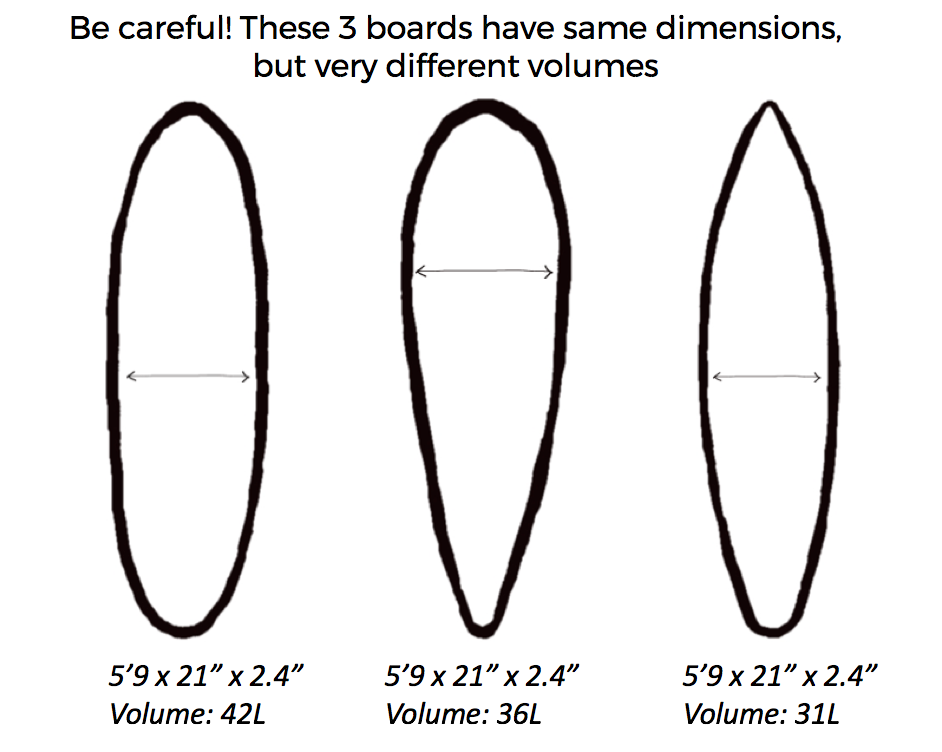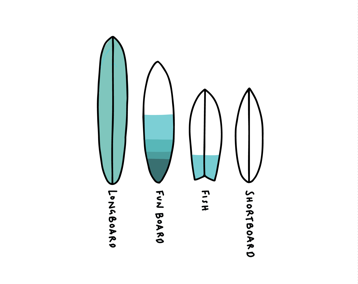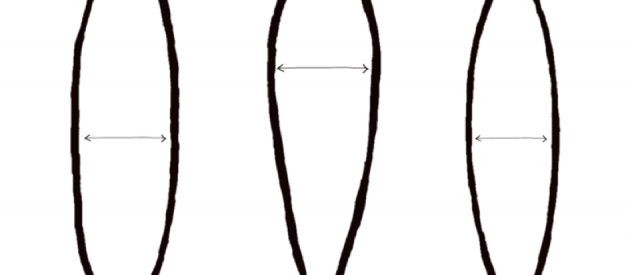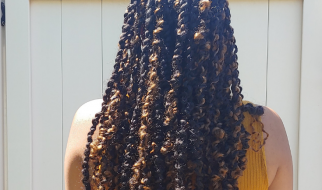This evergreen question is being asked by surfer?s of all abilities. The right board selection can help you to progress faster and have more fun. If you ever wondered:
- what board is the right board for you (size and shape), or
- what are signs that you are ready to handle a shorter / more advanced board
this article is for you. This article will explain you how to choose volume and shape of your next board.
I have also created a cheat sheet to help you decide when are you ready to handle a shorter / more advanced board ? click here to get it.
What kind of surfboard should you get?
There are 3 key concepts to understand when choosing a surfboard:
1, Your board is not a badge of honour (better skills, not shorter boards show who is the boss)
You should view your ability to maneuver (turn, change directions etc) as your goal, not the size of your board. This is not a pissing contest. To improve your surfing the fastest way possible, find what works for your weight and current skill level (more on this below).
2, The most important factor is float (volume relative to your weight)
What volume really tells us, is how well the board will float you in the water. This matters because the more a board floats you, the less drag your body will make when you paddle, and so the faster you?ll be able to move. The faster you can paddle, the more waves you can catch, and the less steep those waves need to be in order to catch them. However, the volume of the board is only half the equation, the other part is the weight of the surfer, as heavier surfers will need more volume to float them.

You can shape 3 boards with the same dimensions, that look and surf very differently
The key ratio here is Volume-to-Weight, which we normally talk about in Pounds per Liter (lbs/L), or Kilos per Liter (kg/l).
To get this number you simply divide the surfers weight by the volume of the board. The higher the resulting number is, the smaller the board is relative to the surfer.
Here are a few pro examples, as you see their height and weight varies, but the volume stays pretty much the same:

Volume is the most useful way to compare the huge range of boards that are now on the market. By now, most brands display the volume of their boards both on their websites and on their surfboards.
Using the below table, you can find a good volume that suits your fitness, ability and comfort level in the surf, and see what boards you can find in that range:

Just multiply the number with your weight to get the volume. If you have to choose between a few, always take the bigger board, you won?t regret it:
- A board that is too big has only one downside; if your technique is weak, you can?t cheat and try to rotate the board with your upper body.
- In theory, the smaller your surfboard, the easier it is to turn with. But smaller boards can also be forced to turn easier with bad technique, which in the long term will hold you back far more. A board that is too small will paddle slow, catch waves late, slows down in turns easier and generally make your surfing look terrible.
- Smaller boards let you trim turns more easily, which can fool you into thinking your carving turns better, but learning to carve turns is actually harder on a low volume board because you have less speed.
3, How to find the right shape
Now that you know what is the right volume for your board, let?s look at shapes!

Typical surfboard shapes. An average shortboard is around 25?35 Litres, while a 7? funboard would be between 40?50L. A longboard might go from 60?100L. A SUP could easily top 250L to give you perspective.
Here is a short summary for the various board types to choose for your skill level:
Longboards
If you are a beginner you should always look for a board which is wide, thick and at least three feet (90 centimeters) taller than you.
Beginner surfers should always get a surfboard with extra flotation and stability to paddle for the wave (2.0lbs/L (0.9kg/L) weight to volume ratio). These super stable surfboards are easier to paddle, will get in the waves faster, and are more forgiving when the pop-up moment arrives and you don?t find the exact balance immediately.
The longboard is best in these conditions:
When the waves are small and rolling, your best bet for fun is a longboard. Because of their large surface area and low rocker, they can catch smaller waves and catch them much earlier. Their mass allows them to glide through flat sections as the momentum of the board is carried. While longboards can be fun in many different conditions, they are the board of choice on small rolling days.
Advantages
- provide stability to help you balance
- floats better so you can paddle faster and catch more waves
- if you go for a soft top in the beginning, it will be safer (lower chance of injury, when it hits you, or god forbid others)
Here is a good summary for the weights and sizes for beginner boards:

Remember to find the right volume for your weight and skill as described in section 2! Image courtesy of https://surfboardsdirect.com.au.
Longboards doesn?t necessarily mean that you are a beginner. They can be fun at a higher skill level and are also great to get back to surfing after a longer break, or a recovery from an injury.
Fun shape/fish style boards
The great thing about the fun shape board is when you change to a shorter and smaller style you can still have the stability that it provides. You definitely don?t want to transition right onto a shortboard after a soft top, because you are going to have a lot of issues with the balance of the board. This board is kind of an intro to a shortboard for beginners. The fun shape boards have a lot of stability that you are going to need as you are progressing and getting better (make sure they are wider than 20? in the middle when you first switch to them).
The fish style board is best in these conditions:
On days when the waves are medium height and have a bit of steepness to them, a fish is a great board choice. The thickness and width of a fish allow it to catch smaller waves and to catch them earlier. The short length and twin fin setup allows them to maneuver more than a longboard though which is why they can be a lot of fun on waves that are 2?4 feet tall. Fish typically have a low rocker which makes them very fast, this is perfect for racing down the line, getting in front of the wave and making a large cutback on the face.
Advantages:
- allow you to continue to improve your paddling
- start to maneuver a lot easier
- easily take your surfing to the next level
- these boards won?t fall apart too quick (they are usually made of heavy duty epoxy )
Checklist ? when to switch from a longboard / soft top?
Before you switch, make sure you already:
- mastered the (soft top) longboard
- got your paddling skills down
- can catch unbroken (green) waves
- can execute a proper pop up (get on your feet without problems.)
- can turn left and right
You can find the right fish for you from this table:

Remember to find the right volume for your weight and skill as described in section 2!
Shortboards
If you feel ready to progress to you first shortboard?
You are already at the stage when you no longer worry about paddling, pop ups and learning the fundamentals of surf turns ? you are already comfortable with all of this.
If you want to open yourself up to new surfing experiences, short boarding is a great way to do so. They are thin, have a good amount of rocker. Shortboards are typically lighter, smaller, faster and float less. Shortboards typically are built with lightness in mind. These boards has less foam so you can push the board under easier which will come in handy for duck diving monster waves. Shortboards also work well inside of long, deep barrels.
The shortboard is best in these conditions:
When the waves are medium in height and pitching, the shortboard is the best board option. These conditions lend themselves to vertical surfing and possibly barrel riding. The shortboard is the best type of surfboard for these surfing styles and a good choice when the conditions allow it.
Advantages:
- allow you to continue to improve the intermediate and advanced maneuvers
- allow you to catch fast, steep and powerful waves
- easily take your surfing to an advanced level
Checklist ? when to switch from a fun shape/ short board?
Before you switch, make sure you already:
- mastered the fun shape/ fish style boards
- got your basic turning skills down (bottom, top turns)
- can catch any waves at any time
- can stay on the wave face and close to the pocket
- can generate speed
- can easily surf front / back side
Cheat sheet ? which board should I choose?
When the waves are between 4?7 feet tall and have a nice medium pitch to them, you can ride any board you want. These are perfect conditions. Because days like this are rare, many people stick with their ?go-to? board but its a perfect time to experiment.
Remember, you should always ride the board that lets you have the most fun in the water. Regardless of what other are riding or what anyone tells you, do what is fun, that?s the point of surfing.
Click here to access the cheat sheet that helps you decide what board is perfect for you


